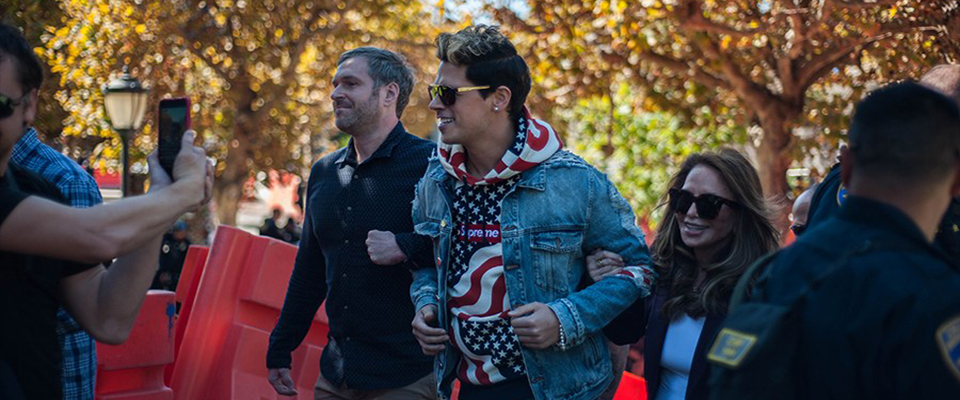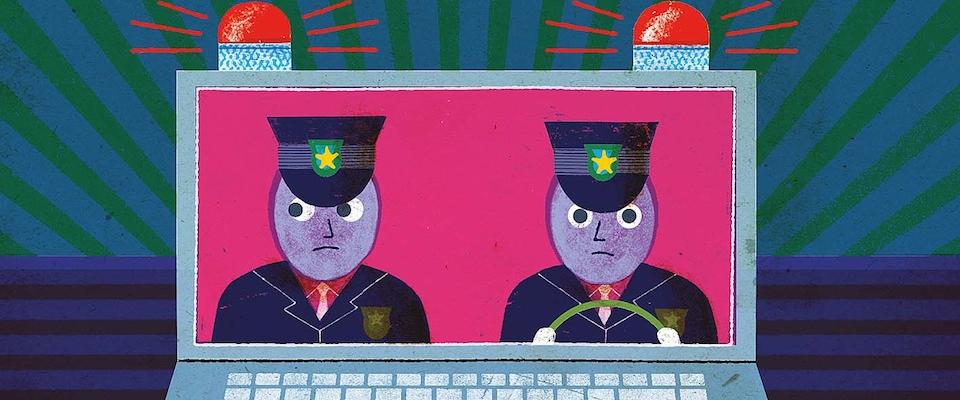I had pizza delivered to a crime scene once. A computer engineer had bludgeoned and stabbed his wife and 12-year-old son to death and then slashed his own throat.
A group of us reporters stood at the edge of the cordoned-off street for hours, waiting for the police to come out and tell us what was going on. We’d already run the plates of the cars in the driveway and figured out who the occupants of the house were, and knew that the man who lived there had co-invented a famous video game. But we needed confirmation that he was the killer before we filed our stories.
It was way past dinnertime and we decided to call for food. Thirty minutes later, a car zipped past the satellite news trucks and stopped. A kid with a funny delivery hat got out, stood for a few minutes gawking past the yellow tape at the rows of police cars and the coroner’s vans, handed us our boxes of pizza, and left. We sat on the sidewalk and ate, while just a few yards away investigators and a forensic team tried to piece together the dead people’s lives.
We did a lot of things like that.
I never covered a murder trial where there wasn’t some kind of reporters’ betting pool. A pool on who would be the jury foreman. A pool on when the jury would return with its verdict. A pool on what that verdict would be. A pool on whether 12 jurors would unanimously vote to send the defendant to death. There was always money involved. Not a lot because we didn’t have a lot, but we liked stakes.
Sometimes even the families of the victims would find out about the pools and participate. Weird, right? But then again, maybe not so strange. The trials were brutal: sometimes tedious, sometimes horrifically graphic, sometimes so heartbreaking they destroyed your faith in humanity. The betting took us to an imaginary Vegas and away from our work.
Gallows humor, some would call it. Hell, it was just plain survival. Days and weeks and months of testimony so depressing my editor once asked, “Doesn’t it make you want to kill yourself?” Not kill myself, but quit and stay home and write romance novels, which I eventually did.
One of the first rules of the job was to never, ever get emotionally involved. Don’t get too close to the victims, to their families. Or to the defendants, who regularly called me collect from jail to profess their innocence. Each one had a sob story that would punch me in the gut if I allowed it to.
That was the thing—I wanted to know their pain for the pages of my newspaper, but I didn’t want to feel it. I worked in a courthouse full of pain, and to be a good reporter I had to compartmentalize.
Like the time a press room full of crime reporters joked that I had been the impetus for a cop’s recent suicide. I joined the chorus of laughter. “Good one,” I said. But secretly I despaired at the notion that a series of articles I had written, outing him as the lead suspect in his wife’s murder, had driven the man to take his life.
“Which brings me to my second rule: There is no crying for newswomen. It’s strictly forbidden.
“You’re not that important,” my husband assured me.
But to this day I still have guilt.
Then there was the white-haired lady with the bluest eyes I’d ever seen. I let her get under my skin even after vowing to maintain objectivity at all costs. Her husband, a car salesman, had been gunned down in their doorway after filing a class-action suit against his employer, alleging that he had withheld commissions. The boss, a wannabe gangster who owned a string of car dealerships with his parents, had hired a hit man. Eventually, after a lengthy investigation, the FBI and the sheriff’s department nabbed him.
The trial was long and emotional. Throughout, I tried to keep a professional distance. But something about the family of the blue-eyed lady sucked me in. They were colorful and kind and so warm that even the stoic bailiffs couldn’t resist them.
The victim’s son was a professional gambler who offered to teach me how to play poker like a pro. Tempted though I was, I politely declined. But when his wife invited me to a lunch she was throwing at her home for everyone involved in the case, I went, convincing myself that I might glean something good for a future story. There was also morbid curiosity involved—this was the very house where the shooting had taken place.
I expected it to be a somber affair, since the guests included an assistant U.S. attorney, a couple of FBI agents, and a few sheriff’s deputies, not to mention the still-grieving family. Instead, they told off-color jokes about the killer and his bevy of blond “bimbos” who came to the courthouse every day.
The blue-eyed widow laughed until she cried. To this day I wonder whether the law enforcement agents, who had become smitten with her just as I had, were making cathartic jokes to salve her anguish or their own. It was the sort of case that left scars.
Which brings me to my second rule: There is no crying for newswomen. It’s strictly forbidden. Not only does it show weakness, it’s considered unprofessional; or worse, pandering to curry favor. Remember that scene in Broadcast News where William Hurt’s character intentionally cries for the camera? Viewers are left with a sudden urge to bathe.
Yet, years ago, I cried until the well ran dry. It was at a press conference. An eight-year-old girl had gone missing, snatched right off the street by a stranger. Jaded reporter that I was, I knew her chances for survival were next to nil. But this little girl beat the odds. She’d escaped the shackles of her pedophile captor and run to safety. As the authorities told of her harrowing escape, I hid behind the broad back of a photographer and wept.
As a tough newswoman, I’m not sure what is harder to admit—that I broke down or that I ate pizza at a crime scene.






















